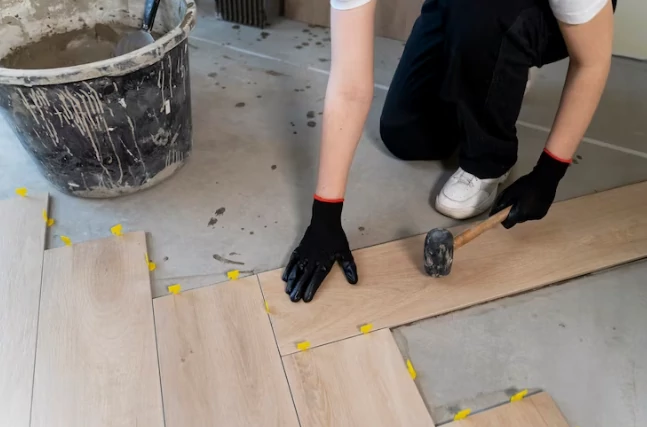Older homes are often cherished for their unique architectural features and timeless design. However, over time, the floors of these homes may become worn out or damaged due to wear and tear. Neglecting floor restoration in older homes can lead to a number of dangers such as tripping hazards, mold growth, and deterioration of the overall structure.
To avoid these risks, it is essential to invest in floor restoration services for older homes. Not only does this ensure safety and longevity of the home, but it also adds value and enhances its aesthetic appeal.
In this article, we will explore the benefits of floor restoration in older homes and provide insight into the process involved in restoring floors to their former glory.
The Dangers of Neglecting Floor Restoration in Older Homes
Neglecting floor restoration in older homes can result in potentially hazardous living conditions and decreased property value. Floors that are not properly maintained may have weakened structural integrity, which can lead to accidents such as tripping and falling. This is especially dangerous for older adults and children who are more prone to falls. Additionally, unattended floors may accumulate moisture, dust, and debris that can trigger allergies or respiratory problems.
Furthermore, the deterioration of floors greatly affects the overall appeal of a house. Potential buyers will be put off by uneven or damaged flooring, resulting in reduced property value. In some cases, owners may be required to replace their entire flooring due to severe damage caused by neglect.
It’s essential for homeowners to understand the importance of restoring their floors before it’s too late – not only for safety reasons but also for financial ones. Proactive maintenance ensures that the home retains its original charm while providing a safe environment for its occupants.
The Benefits of Floor Restoration
One advantage of refurbishing deteriorated flooring is the ability to enhance the aesthetic appeal and value of a property. Old homes have a unique charm that attracts people due to their historical significance, architectural style, and character. However, with age, floors can become worn out, stained, or damaged by pests or water leaks.
Floor restoration provides an opportunity to bring back the original beauty of the house while preserving its authenticity.
Furthermore, floor restoration can improve the functionality and safety of a home. Cracked or uneven surfaces pose a risk for tripping accidents that can result in severe injuries. Additionally, gaps between floorboards provide entry points for insects and rodents that damage wooden structures and contaminate indoor air quality.
By fixing these issues through proper restoration techniques such as sanding, refinishing, and sealing with eco-friendly products, homeowners can create safer living spaces that promote well-being and reduce maintenance costs in the long run.
The Process of Floor Restoration
Floor restoration involves a systematic process that aims to restore the original beauty and functionality of old floors. The process includes three key stages:
– Evaluation and preparation: during this stage, the condition of the floor is assessed, repairs are made, and any necessary cleaning or stripping is done to prepare the surface for refinishing.
– Sanding and staining: this stage involves removing old finishes from the wood surface using specialized machinery before applying new stains or finishes.
– Sealing and maintenance: sealing ensures that the floor is protected against moisture, scratches, and other forms of damage while also enhancing its durability. Maintenance involves regular cleaning using appropriate tools and products to ensure that your restored floor remains in good condition for years to come.
Evaluation and Preparation
Assessing the condition of the subfloor is a crucial step in the evaluation and preparation process for restoring older home floors, as it serves as the foundation for any subsequent repairs or installations.
The first step in evaluating your subfloor involves checking for any structural damage. This includes looking for signs of rot, water damage, or termite infestation. Any such issues must be addressed before proceeding with any restoration work.
After assessing any structural damage to the subfloor, you should then check its levelness. An uneven floor can lead to further structural problems and make it difficult to install new flooring materials properly.
It is also important to examine the overall stability of your subfloor and identify any weak spots that may require reinforcement or replacement before starting on your restoration project.
By taking these steps during evaluation and preparation, you can ensure that your restored flooring will have a stable foundation and minimize further issues down the line.
Sanding and Staining
During the sanding and staining process, it is important to use proper safety equipment such as a dust mask and eye protection to prevent any potential health hazards. Sanding old floors can release harmful dust particles into the air that may cause respiratory problems or exacerbate existing conditions such as allergies or asthma.
In addition, some wood stains contain volatile organic compounds (VOCs) which can also pose health risks if inhaled. Therefore, it is crucial for homeowners to take the necessary precautions before beginning the sanding and staining process.
The first step in sanding involves removing any previous finishes or coatings on the floor using a floor sander. This machine uses abrasive paper to remove layers of old finish and smooth out any imperfections on the surface of the wood. It is essential to ensure that all areas of the floor are sanded evenly to avoid uneven stain absorption later on.
Once this process is complete, homeowners can move on to staining their newly restored floors using a variety of colors and finishes available on the market today. By taking care during this step, homeowners can achieve an even distribution of color while protecting their own health at the same time.
Sealing and Maintenance
After completing the staining process, sealing and maintenance are crucial steps in ensuring the longevity of the newly restored wood floors. Sealing protects the surface of the floor from moisture, dirt, and other contaminants that can cause damage over time. It also helps to prevent scratches and scuffs from daily wear and tear.
There are several options for sealing a newly stained floor, including polyurethane and wax finishes. Polyurethane is a popular choice due to its durability and ease of application. Wax finishes provide a more traditional look but require more frequent maintenance.
Regardless of the type of sealant used, it is important to follow manufacturer instructions carefully to ensure proper coverage and drying times. Regular maintenance, such as sweeping or vacuuming regularly and avoiding harsh cleaning chemicals, can also help prolong the life of the newly restored floors.
Frequently Asked Questions
How much does floor restoration typically cost?
The cost of floor restoration varies widely depending on the type of wood, the condition of the floor, and the size of the area. On average, homeowners can expect to pay between $3 to $8 per square foot for professional restoration services.
How long does the floor restoration process typically take?
The floor restoration process duration varies depending on the extent of damage and the size of the area. It can take anywhere from a few days to several weeks, making it crucial to plan accordingly for minimal disruption in daily activities.
Is floor restoration a DIY project or should I hire a professional?
Floor restoration is a complex process that requires professional expertise. Attempting to restore floors as a DIY project can result in irreparable damage, which may ultimately lead to higher costs. Hiring professionals ensures quality work and longevity of the restored floors.
What types of flooring can be restored?
Floor restoration can be done on various types of flooring including hardwood, engineered wood, and concrete. The process involves sanding, refinishing, and repairing to restore the floor’s original beauty. Professional help is recommended for best results.
Will floor restoration increase the value of my older home?
Floor restoration has been found to increase the value of older homes, as it enhances the aesthetic appeal and functionality of the flooring. This is particularly true for hardwood floors which are durable and timeless in their appeal.
Conclusion
The restoration of floors in older homes is an important process that should not be neglected. The dangers of neglecting floor restoration can lead to structural problems, safety hazards, and a decrease in property value.
On the other hand, restoring floors can provide numerous benefits such as enhancing the aesthetic appeal of your home, improving indoor air quality, and increasing property value.
The process of floor restoration involves several stages including cleaning, sanding, staining, and sealing. It requires specialized skills and expertise to ensure that the job is done correctly. Although it can be time-consuming and expensive, investing in this process will pay off in the long run by adding years to your home’s lifespan.



